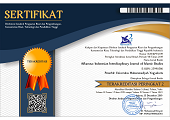Perbandingan Keterampilan Intrapersonal dan Interpersonal Berbasis Pendidikan Karakter Siswa Sekolah Dasar Negeri Kasihan Bantul
Abstract
Keywords
Full Text:
PDFReferences
Amstrong, T. 1994. Multiple Intelligences in The Classroom. Virginia: ASCD
Anderson,L.W. 1981..Assessing Affective Characteristics in the Schools.Boston: Allyn and Bacon.
Ayan, Jordan E. 2003. AHA!: 10 Ways to Free Your Creative Spirit and Find Your Great Ideas, Terj: Ibnu Setiawan, Bandung: Mizan.
Coopersmith, Stanley. 1986. Self-Esteem Inventory, Palo Alto, California: Consulting Psychologist Press.
Cunningham, William G. and Paula A.Corderio. 2003. Educational Leadership: A Problem Based Approach. Boston: Pearson Education.
David A.Whetten.,Kim S.Cameron. 1991. Developing Management Skills, New York: Harper Collin Publishers.
Diknas, RI. 2004. Kurikulum SD/MI berdasarkan KTSP, Jakarta: Puskur Diknas.
Gardner, Howard. 1993. Frames of Mind: The Theory of Multiple Intelligence, New York: Basic Books.
Goleman, Daniel. 2005. Emotional Intelligence, Terj: T.Hermaya, Jakarta: Gramedia.
Hurlock, Elizabeth B. 1991. Perkembangan anak. (Terj: Metasari dan Tjandrasa dan Muslichah Zarkasih. Jakarta: Erlangga.
Karen E,Bohlin. 2005. Teaching character Education Through Literature, Awakening the Moral Immagination Second ary Classrooms. New York: RoutledgeFalmer.
Kilpatrick. 1992. Why Johny can’t tell right or wrong, and what we can do about it. New York: A Touchstone Book.
Kirschenbaum,H. 1995. Enhance Values and Morality in Schools and Youth, Setting. Boston: Allyn and Bacon.
Kohlberg, Lawrence, (terj) John de Santo, Tahap-Tahap Perkembangan Moral, Yogyakarta: Kanisius.
Larry P.Nucci, 2008. Handbook of Moral and Character Education, New York and London: Routledge.
Lazear, David. 2000. Pathways of Learning: Teaching Students and Parents about Multiple Intelligences. Arizona: Zephyr.
Lickona, Thomas. 1992. Educating for character, how our schools can teach respect, Respect and Responsibility, New York: Bantam Books.
____________ . 1975. Moral Development and Behaviour: Theory, research, and Social Issues. New York: States University of New York.
Lwin, May et al. 2005. How to Multiply Your Child’s Intelligence. Terj: Christine S. Jakarta: Indeks.
Mant, Alistair. 1997. Intelligent Leadership, New South Wales: Allen & Unwin.
Piaget,J. (1950. The Psychology of Intelligence, New York: Harcourt, Brace&World.
Pusat Bahasa Depdiknas. 2005. Kamus Besar Bahasa Indonesia, Edisi ke III. Jakarta: Balai Pustaka.
Ratna Megawangi. 2004. Pendidikan karakter: Solusi yang tepat untuk membangun bangsa. Jakarta: Star Energy (Kakap) Ltd.
Rohendi. 2004. “Moral yang tereliminasi.” Pikiran Rakyat 15 Juli 2004.
Rose, Collin and Malcolm J. Nicholl. 2002. Accelerated Learning for the 21st Century, Terj: Dedy Ahimsa. Bandung: Nuansa.
Sax,G. 1980. Principles of educational psychological measurement and educational an evaluation. Balmont, CA: Wadswort Publising Co.
Schon, D. 1990. Educating the reflective practitioner. Artikel. Diambil pada tgl 12 Desember 2010, dari http://www.reflectiveaction.com/home.html.
Sudarminta. 2002. Pendidikan dan Pembentukan Watak yang Baik, Dalam Tilaar: Pendidikan untuk Masyarakat Indonesia Baru, Jakarta: Grasindo.
Tadkiratun Musfiroh. 2008. Character Building, Yogyakarta: Tiara Wacana.
Tilaar, HR. 2006. Pembangunan watak dan karakter dengan penciptaan kultur sekolah, Kompas, 8 Maret p.12.
Zamroni, 2005. Pengembangan Sistem Penilaian Pendidikan yang menerapkan KBK dalam Kerangka Otonomi Daerah. Yogyakarta: HEPI.
Zuchdi, Darmiyati. 2010. Humanisasi Pendidikan, Menumbuhkan Kembali Pendidikan yang Manusiawi, Jakarta: Bumi Aksara.
____________ . 2009. Pendidikan Karakter, Grand Design dan Nilai-Nilai Target, Yogyakarta: UNY Press
DOI: https://doi.org/10.18196/aiijis.2013.0019.50-64
Refbacks
- There are currently no refbacks.
Copyright (c) 2015 Afkaruna: Indonesian Interdisciplinary Journal of Islamic Studies

This work is licensed under a Creative Commons Attribution-ShareAlike 4.0 International License.
Afkaruna: Indonesian Interdiciplinary Journal of Islamic Studies indexed by:












1.png)


